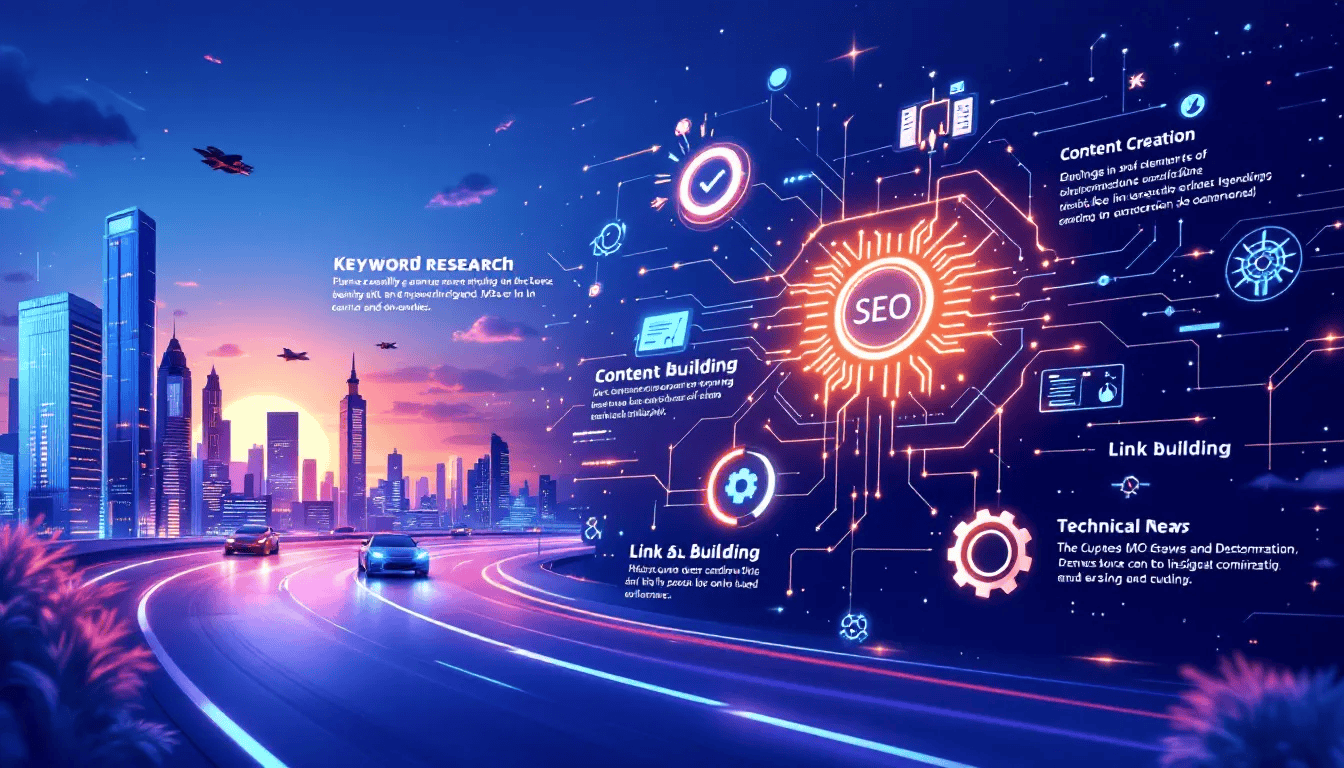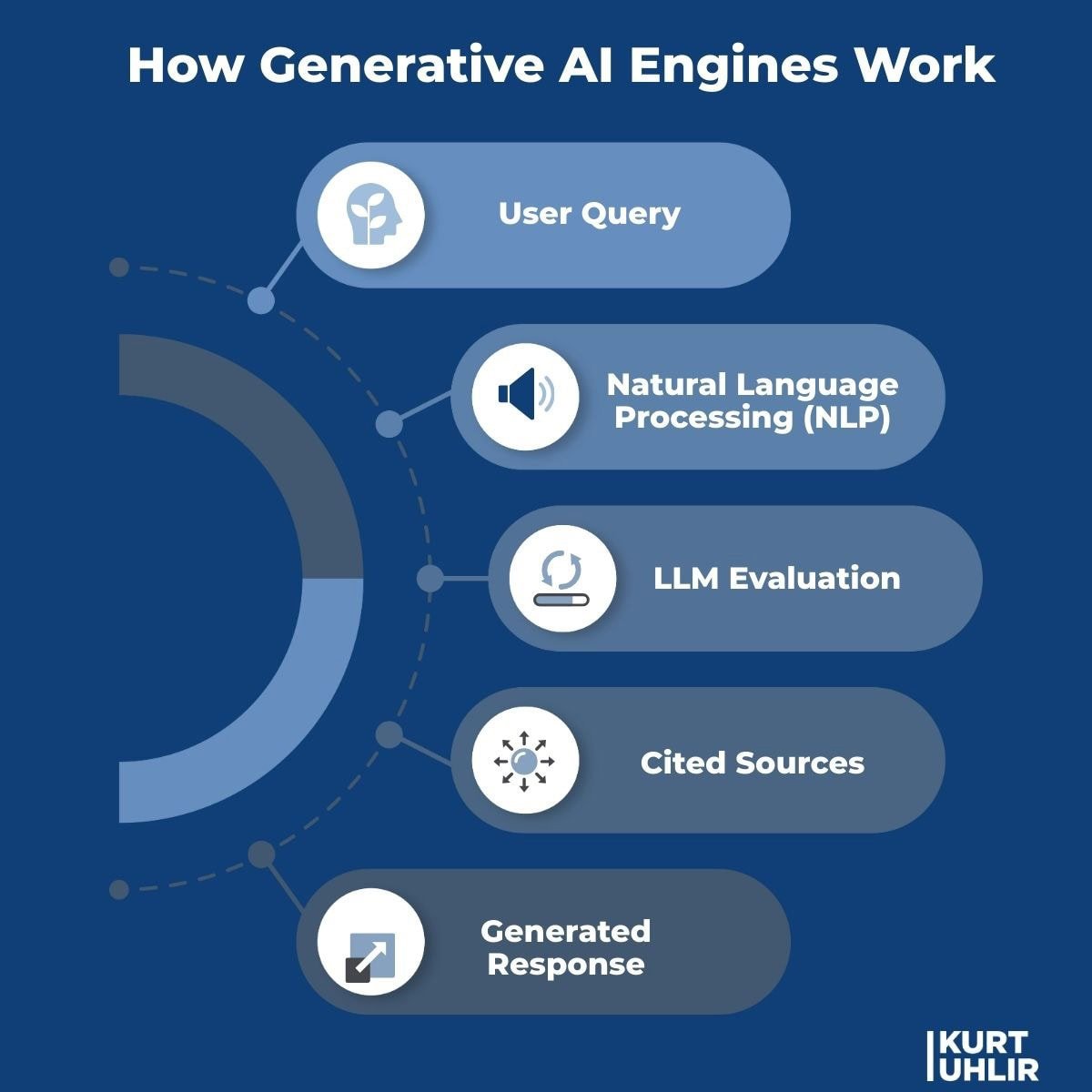Maximize Your Demand Gen Strategy with Answer Engine Optimization Today
What happens when AI disrupts search? Your business either adapts or disappears. Answer engine optimization (AEO) isn’t just another marketing buzzword—it’s your competitive advantage in an AI-first world.
Unlike traditional search engines that drive website traffic, answer engines deliver immediate, zero-click responses through AI platforms like ChatGPT and Google SGE. This shift demands a complete rethinking of your digital marketing strategy.
Key Takeaways
- Answer Engine Optimization (AEO) focuses on delivering immediate, concise answers to user queries using AI technology, contrasting with traditional SEO that enhances website visibility.
- The rise of generative AI and voice search assistants has transformed user expectations, making AEO essential for businesses aiming to provide accurate, instant information.
- Implementing AEO strategies, including keyword research, structured data markup, and user feedback integration, can significantly improve content visibility and user engagement.
Understanding Answer Engine Optimization (AEO)

Answer engine optimization (AEO) strategically structures your content to provide direct answers to user queries through AI platforms. It’s the deliberate formatting of information to be instantly accessible by artificial intelligence and answer engines.
First, let’s clear up terminology. The digital marketing world hasn’t settled on a single term yet, and you’ll hear these used interchangeably:
- AEO (Answer Engine Optimization)
- AIO (AI Optimization)
- CEO (Chat Engine Optimization)
- GEO (Generative Engine Optimization)
- LMO (Language Model Optimization)
They all represent the same core concept: optimizing content for AI-driven, zero-click answers in search results.
The rise of generative AI has fundamentally altered how users interact with search engines. This shift is driven by growing demand for instant, precise answers that reflects significant changes in search behaviors.
Answer engine optimization intersects directly with retrieval-augmented generation (RAG), which combines retrieval of relevant content with generation of natural language summaries. This enhances accuracy and relevance of the answers provided by AI answer engines.
Experience, Expertise, Authoritativeness, and Trustworthiness (EEAT) factors play a crucial role in shaping effective AEO strategies. Web pages must be reliable, well-structured, and clearly establish authority on topics to achieve maximum visibility in answer engines and search engine results.

Examples of Answer Engines
Answer engines fall into two main categories, each requiring specific optimization approaches:
AI Chatbots: ChatGPT, Gemini, Claude, Perplexity
ChatGPT leads with nearly 60% market share as of January 2025, surpassing even Instagram and TikTok in usage. While it excels in engaging users with context-rich dialogues, it occasionally produces plausible but incorrect responses.
Perplexity AI provides concise answers aligned with conversational search queries, ensuring both succinctness and credibility. These AI answer engines use machine learning to understand user intent and deliver relevant content.
These platforms fall into two distinct types:
- Generative-only engines like ChatGPT and Claude focus on generating responses from training data
- Retrieval-augmented engines like Perplexity and Bing Copilot combine data retrieval with response generation for more accurate answers
Google’s Gemini integrates directly with Google products like Docs, Sheets, and Gmail, creating an ecosystem that demands visibility for your content. These AI tools continuously train on live web results, discussion forums, and schema, ensuring that the answers they provide are up-to-date and relevant to search queries.
Voice Search Assistants: Alexa, Siri, Google Assistant
Voice search continues growing, with 41% of the U.S. population using voice search daily. More telling: 65% of Google Home or Amazon Echo owners now prefer this method over typing.
The key difference? Voice search queries are longer and more conversational, reflecting natural language processing patterns. Schema.org’s “Speakable” markup was specifically designed to assist with voice-read answers.
Voice assistants and AI-powered voice assistants like Google Assistant rely on voice recognition technology to interpret and respond to user questions effectively. Smart devices have accelerated the adoption of voice search, changing how users interact with search engines and answer engines.
Despite pioneering this space, Amazon Echo has fallen behind competitors after introducing a $20 monthly fee for previously free functionality—a cautionary tale about user experience in the answer engine space.
The Shift from Traditional Search Engines to Answer Engines

The rise of answer engines has transformed information retrieval fundamentally. Unlike traditional search engines, the integration of artificial intelligence provides users with direct answers in search engine results pages.
Users now frame search queries as questions, expecting immediate answers. Answer engines use advanced AI to understand search intent, making them capable of generating contextually relevant answers—especially critical for voice searches.
Recent search algorithms prioritize passage-based retrieval, often citing forums like Reddit, StackOverflow, and niche blogs. This represents a significant change from traditional SEO strategies that focused primarily on keyword stuffing and link building.
Vector search and embedding-based content matching are gaining importance, forcing businesses to adapt their answer engine optimization strategies or risk invisibility in search engine results.
AEO vs. SEO: What’s Really Different?

The objective difference is clear: traditional SEO drives traffic to your website; answer engine optimization delivers direct answers to users. This shift impacts everything from content strategy to measurement.
Objective Comparison
| Answer Engine Optimization | Search Engine Optimization |
| Reduces search time with immediate, precise answers | Increases website ranking in search engine results pages |
| Focuses on natural language processing | Targets keyword optimization |
| Measures featured snippets and chat summaries | Tracks CTR and rank positions |
| Emphasizes concise answers | Requires longer-form content |
| Drives organic traffic through answer boxes | Drives traffic through blue links |
Unlike traditional search engines that prioritize website visibility, answer engines focus on delivering the most relevant content directly to users, often eliminating the need to visit the source website.
Traditional SEO focuses on optimizing full pages for ranking in search results, whereas answer engine optimization concentrates on structuring content for featured snippets and direct answers.
Content Structure and User Engagement
Effective AEO content prioritizes concise, structured responses that AI can quickly pull and present. Users expect instant answers without scrolling—brevity is essential for answer engine optimization.
For optimal user interaction, structure content in question-and-answer format with a strong H2 headline followed by a 2-3 sentence summary. This lead-with-answer structure lets answer engines easily extract and present your in-depth information.
Structured data plays a crucial role in AEO as it helps search engines understand the content type and improve visibility in search engine results pages. Using structured data markup like schema.org aligns your content with search engine expectations, ensuring it meets user intent and delivers accurate information delivery.
Implement Answer Engine Optimization: Win the AI Answer Game

To maximize your answer engine optimization impact and strengthen your SEO strategy, follow these action steps:
1. Conduct Keyword Research for AEO
Identify common user questions to guide your content strategy:
- Mine high-volume search queries using tools like Answer the Public, AlsoAsked, and People Also Ask data
- Incorporate relevant keywords and long-tail keyword phrases tied to verbs and problem-solving terms
- Study search behaviors and patterns for insight into explicit intent
- Optimize content for voice search by adopting conversational tone
Your keyword research must account for how people naturally ask questions, not how they type them. Conduct keyword research specifically focused on question formats that answer engines typically surface.
2. Deploy Structured Data Markup
Add structured data to improve content relevance and increase chances of appearing in featured snippets and rich search results:
- Use Schema.org schemas like FAQ pages, QAPage, Speakable, HowTo, and Product
- Implement via JSON-LD, microdata, or RDFa
- Validate with Rich Results Test
- Integrate directly in HTML head or via your CMS
Structured data markup isn’t optional—it’s how you communicate content context to answer engines and traditional search engines alike. Structured data helps search engines understand what questions your content answers.
3. Enhance Business Visibility
Implementing answer engine optimization significantly enhances brand visibility in AI-generated responses. Focus on:
- Listing your information on directories like Google My Business
- Leveraging AI tools to automate your AEO processes
- Monitoring user behaviors and search trends with Google Search Console dashboard
- Adding alt text for images and transcripts for videos
- Ensuring keyboard navigability for accessibility
- Creating compelling calls-to-action in featured snippets to encourage user interaction
Technical SEO remains important, but must now be complemented with strategies specifically designed for answer engines and featured snippets.
Platform-Specific Optimization: Dominate Every Answer Engine
Each major answer engine has unique preferences. Here’s your tactical playbook for the top four:
ChatGPT (OpenAI GPT-4o): The Authority Seeker
ChatGPT operates like a well-trained research assistant, heavily favoring high-authority, neutral sources:
- Earn mentions from reference-style sources. ChatGPT shows clear preference for Wikipedia, scholarly summaries, and editorially neutral content.
- Contribute to major blogs and news sites. In recent datasets, ~27% of citations came from news outlets, while another ~21% originated from authoritative blogs.
- Avoid purely promotional content. UGC, forums, social media, and vendor product pages are almost entirely excluded from GPT-4o’s citations.
- Build a strong digital footprint beyond your own site. Non-commercial sources often get preference in large language models, with backlinks from respected domains carrying more semantic value than traditional link building.
Google Gemini (2.0 Flash): The Balanced Synthesizer
Gemini attempts to synthesize trusted media with user feedback:
- Leverage high-authority blogs. Blogs accounted for nearly 40% of citations in recent testing, making them a cornerstone of Gemini visibility.
- Integrate media formats—especially YouTube. YouTube was the most cited single domain (~3%), with video content tied to search queries showing significant boost in relevance.
- Distribute across news and commentary outlets. Forbes, PCMag, and similar sites were consistently cited, with Gemini showing strong appetite for structured reviews.
- Focus on breadth. Content appearing across multiple formats (articles, videos, Q&A) will be more easily surfaced through Gemini’s internal synthesis.
Perplexity AI (Sonar Mode): The Expert and Review Curator
Perplexity favors depth over generality, prioritizing expert-driven, factual content:
- Target trusted review domains. Sites like NerdWallet, Investopedia, and Consumer Reports consistently appear in citations.
- Invest in blog/editorial authority. Blogs made up ~38% of citations, while news accounted for another 23%.
- Encourage expert-led discussions. Forums like Reddit are sometimes cited—especially in ecommerce—but only when content is high-signal.
- Create comparison and guide content. Structured articles such as “best X for Y” and feature breakdowns tend to perform well in answer boxes and featured snippets.
Google AI Overviews: The Broad Aggregator
Google’s AI Overviews reflects the widest citation mix of all four answer engines:
- Invest in blog-style content. Blogs make up ~46% of cited sources, with well-organized, in-depth information performing best.
- Embrace community-driven platforms. Reddit was the most cited single source, with Quora and YouTube also highly visible.
- Create deep, specific web pages. Over 82% of SGE citations pointed to deeply nested URLs—not homepages or top-level category pages.
- Include structured Q&A and list formats. “Top 10” lists, comparison tables, and FAQ pages increase citation chances in featured snippets.
- Don’t ignore vendor blogs. ~7% of AI Overview citations came from vendor-authored product blogs that provided valuable insights.
Enhancing User Experience with AEO
Enhancing user experience requires aligning content with user intent and ensuring accessibility. Users increasingly prefer immediate answers from AI assistant and voice assistants over traditional search results.
Improving accessibility means:
- Incorporating user feedback mechanisms
- Adding alt text for images
- Creating transcripts for video content
- Structuring quick answers above the fold, especially on mobile
- Implementing in-page navigation
- Using expandable FAQ pages
- Applying semantic HTML tags
These strategies ensure your content meets the expectations of your target audience across all devices and platforms. Optimize content specifically for how answer engines and search engines extract information from your web pages.
Future Trends in Answer Engine Optimization
The future of answer engine optimization is being shaped by several key developments:
- Rise of AI assistant and AI-generated answers as primary information sources (25% of Americans now use AI models instead of traditional search engines)
- Growing voice search adoption with natural, conversational language patterns
- Large language models and vector memory expansion influencing content relevance and discovery
- Brand inclusion into RAG pipelines affecting visibility in AI results
- Increased authority weighting for content from Reddit, Quora, GitHub, and niche blogs
Businesses that anticipate these shifts will maintain competitive advantage in the rapidly evolving answer engine optimization landscape. As search engines continue to evolve, answer engines will play an increasingly central role in delivering search results.
Ongoing Challenges and Solutions
The dynamic nature of search algorithms poses significant challenges for answer engine optimization strategies. Address these through:
- Continuous monitoring and adaptation to algorithm updates using Google Analytics and Google Search Console dashboard
- Balancing featured snippets value with click incentives by embedding brand viewpoints and linking to deeper resources
- Using GPT detectors to ensure content isn’t overly generic
- Adding author bios to strengthen EEAT signals
- Monitoring inclusion in AI citations via API or manual tracking to refine your approach
Traditional SEO strategies must evolve to incorporate these new answer engine optimization techniques while maintaining focus on technical SEO fundamentals. Answer engines demand content that directly addresses user queries with precise answers.
The Bottom Line: Act Now or Be Left Behind
Answer engine optimization isn’t optional—it’s essential for survival in the AI era. By optimizing content for zero-click answers through AI-driven platforms, you’ll meet the growing demand for immediate, precise answers in search results.
Understanding the differences between answer engine optimization and traditional SEO, implementing structured data markup, and conducting thorough keyword research are essential steps in dominating the AI-driven information landscape.
The businesses that thrive in this new reality will be those that understand both the technical requirements and the strategic implications of AI-driven search engines. Start implementing these answer engine optimization strategies today, and position yourself at the forefront of this fundamental shift in how users interact with search results.
Will your content be the answer engines’ choice to share in featured snippets, or will it be buried in the digital noise? The choice—and the action—is yours.
Frequently Asked Questions
What is Answer Engine Optimization (AEO)?
Answer Engine Optimization is a digital marketing strategy aimed at refining content to deliver direct answers to user queries via AI-powered platforms. This approach enhances visibility in search engine results pages and user satisfaction in increasingly competitive online environments.
How does AEO differ from traditional SEO?
Unlike traditional search engines that focus on improving website rankings and driving organic traffic, answer engine optimization prioritizes immediate, AI-generated answers. This shift emphasizes user intent and efficient information delivery through featured snippets and answer boxes.
What are some examples of answer engines?
Examples include AI answer engines such as ChatGPT and Claude, along with voice search assistants like Alexa, Siri, and Google Assistant. These tools leverage natural language processing and machine learning to answer questions with quick, precise answers.
Why is structured data important for AEO?
Structured data is vital for answer engine optimization as it enhances search engines’ comprehension of content types, thereby increasing visibility in featured snippets and rich search results. This ultimately improves the effectiveness of your content in delivering accurate information to your target audience.
What future trends should businesses watch for in AEO?
Businesses should watch for the rise of AI assistant integration, the increasing significance of voice search, and the visibility of niche content driven by authority weighting. These trends will be crucial for maintaining competitive advantage in the answer engine optimization landscape as traditional search engines evolve.











